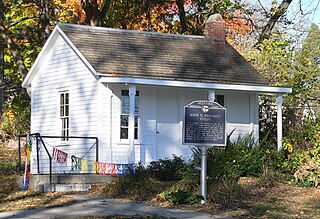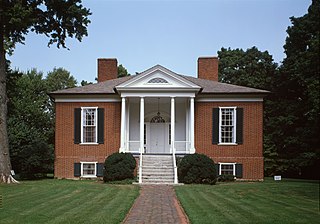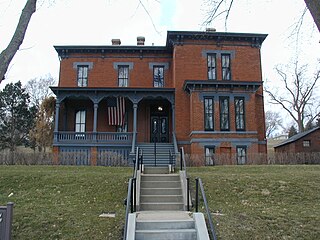
Bancroft is a village in Cuming County, Nebraska, United States. The population was 495 at the 2010 census.
John Gneisenau Neihardt was an American writer and poet, amateur historian and ethnographer. Born at the end of the American settlement of the Plains, he became interested in the lives of those who had been a part of the European-American migration, as well as the Indigenous peoples whom they had displaced.

Black Elk Peak is the highest natural point in the U.S. state of South Dakota and the Midwestern United States. It lies in the Black Elk Wilderness area, in southern Pennington County, in the Black Hills National Forest. The peak lies 3.7 mi (6.0 km) west-southwest of Mount Rushmore. At 7,244 feet (2,208 m), it is the highest summit in the United States east of the Rocky Mountains. Though part of the North American Cordillera, it is generally considered to be geologically separate from the Rocky Mountains.

Wright Marion Morris was an American novelist, photographer, and essayist. He is known for his portrayals of the people and artifacts of the Great Plains in words and pictures, as well as for experimenting with narrative forms.

Buffalo Bill Ranch State Historical Park, known as Scout's Rest Ranch, is a living history state park located west of North Platte, Nebraska. The ranch was established in 1878 with an initial purchase of 160 acres south of the Union Pacific tracks by William Cody. The 4,000 acre ranch was sold in 1911 and has been under the management of the Nebraska Game and Parks Commission since 1964. The 25 acre historic state park, added to the National Register of Historic Places in 1978 and designated a National Historic Landmark in 2021, is open weekdays from April to October. The house and outbuildings can be toured, including a museum documenting Cody's life from a Pony Express rider to his Wild West shows.

This is a list of more than 1,100 properties and districts in Nebraska that are on the National Register of Historic Places. Of these, 20 are National Historic Landmarks. There are listings in 90 of the state's 93 counties.

Farmington, an 18-acre (7.3 ha) historic site in Louisville, Kentucky, was once the center of a hemp plantation owned by John and Lucy Speed. The 14-room, Federal-style brick plantation house was possibly based on a design by Thomas Jefferson and has several Jeffersonian architectural features. As many as 64 African Americans were enslaved by the Speed family at Farmington.
Hilda Neihardt (1916–2004) was one of her father John G. Neihardt's "comrades in adventure," and at the age of 15 accompanied him as "official observer" to meetings with Black Elk, the Lakota holy man whose life stories were the basis for her father's book, Black Elk Speaks and for her own later works.

Rancho Petaluma Adobe is a historic ranch house in Sonoma County, California. It was built from adobe bricks in 1836 by order of Mariano Guadalupe Vallejo. It was the largest privately owned adobe structure built in California and is the largest example of the Monterey Colonial style of architecture in the United States. A section of the former ranch has been preserved by the Petaluma Adobe State Historic Park and it is both a California Historic Landmark and a National Historic Landmark. The Rancho Petaluma Adobe State Historic Park is located on Adobe Road on the east side of the present-day town of Petaluma, California.

The Malcolm X House Site located at 3448 Pinkney Street in North Omaha, Nebraska, marks the place where Malcolm X first lived with his family. The site was listed on the National Register of Historic Places in 1984 and is also on the Nebraska list of heritage sites.

Rutherford House is a historic building and museum in the Strathcona area of Edmonton, Alberta, Canada. The structure was the home of the first Premier of Alberta, Alexander Cameron Rutherford, from 1911 to 1941, and has subsequently been designated as an Alberta provincial historic site.

The Clinton House is an 18th-century Georgian stone building in the city of Poughkeepsie, Dutchess County, New York, United States. It is a New York State Historic Site and has been listed in the National Register of Historic Places as a historic place of local significance since 1982. The house was named for George Clinton, who served as the first Governor of New York and fourth Vice-President of the United States. He was believed to have lived there after the American Revolutionary War, but it is now known that it was never his residence.

The General George Crook House Museum is located in Fort Omaha. The Fort is located in the Miller Park neighborhood of North Omaha, Nebraska, United States. The house was listed on the National Register of Historic Places in 1969, and is a contributing property to the Fort Omaha Historic District.

The Murie Ranch Historic District, also known as the STS Dude Ranch and Stella Woodbury Summer Home is an inholding in Grand Teton National Park near Moose, Wyoming. The district is chiefly significant for its association with the conservationists Olaus Murie, his wife Margaret (Mardy) Murie and scientist Adolph Murie and his wife Louise. Olaus and Adolph Murie were influential in the establishment of an ecological approach to wildlife management, while Mardy Murie was influential because of her huge conservation victories such as passing the Alaska National Interest Lands Conservation Act of 1980 and being awarded with the highest civilian honor, the Presidential Medal of Freedom, for her lifetime works in conservation. Olaus Murie was a prominent early field biologist in the U.S. Biological Survey and subsequent U.S. Fish and Wildlife Service before retiring and becoming the president of the Wilderness Society, He was a prominent advocate for the preservation of wild lands in America.

The Willa Cather House, also known as the Willa Cather Childhood Home, is a historic house museum at 241 North Cedar Street in Red Cloud, Nebraska. Built in 1878, it is the house where author Willa Cather (1873–1947) grew up. Cather's descriptions of frontier life in Nebraska were an important part of literary canon of the early 20th century. The house was declared a National Historic Landmark in 1971. The house is one of eight structures that make up the Willa Cather State Historic Site, which is owned by the Willa Cather Foundation.

Leary Site, also known as 25-RH-1 or Leary-Kelly Site is an archaeological site near Rulo, Nebraska and the Big Nemaha River. The site now lies entirely on the reservation of the Iowa Tribe of Kansas and Nebraska. The area was once a village and burial site.

The Pavelka Farmstead, also known as the Antonia Farmstead, is a house located near Bladen in rural Webster County in south-central Nebraska, on land once owned and occupied by John and Anna Sadilek Pavelka. The farmstead provided a setting, and its occupants characters, for several of the works of author Willa Cather, who grew up in Webster County.

The Schnull–Rauch House, sometimes referred to as the Victorian Manor and now also branded as The Manor at The Children's Museum of Indianapolis, is a National Register of Historic Places-designated Romanesque Revival historic home constructed in the early 20th century at 3050 North Meridian Street, north of downtown Indianapolis, Indiana.

John Turner was an American fur trapper and guide who first entered Oregon Country in 1828 and became an early resident of the Willamette Valley. Later he moved to California where he was part of the second attempt to rescue the Donner Party.

The Fowler-Steele House, also known historically as Ivy Hall, is a historic house on North Main Street in Windsor, Vermont, United States. Built in 1805 and restyled about 1850, it has an architecturally distinctive blend of Federal and Greek Revival styles. It served for many years as a local church parsonage. It was listed on the National Register of Historic Places in 1982.





















